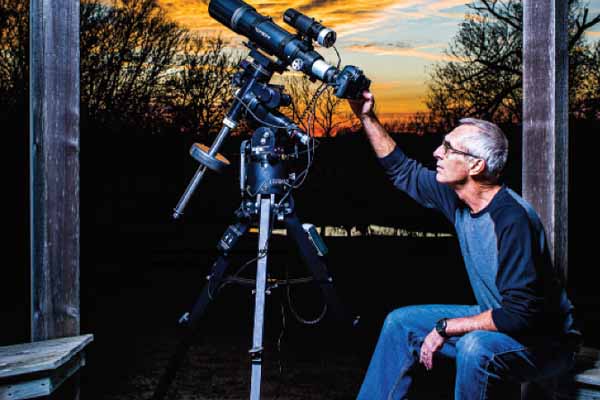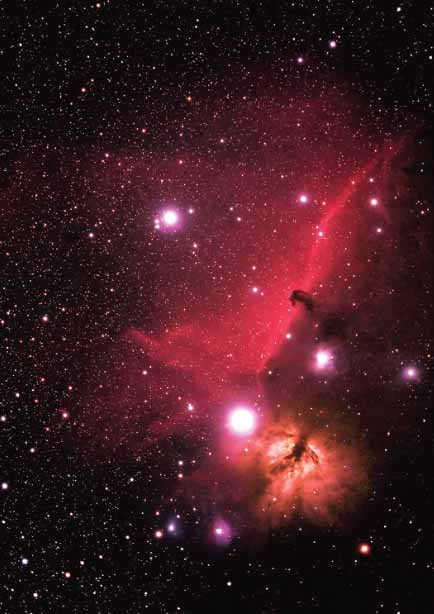
Ever since he was a boy, Temple family physician John Manning, MD, has been fascinated by space.
“I watched Alan Shepherd’s first launch into space around age 7, and that got me hooked on space and flying and the sky,” said Dr. Manning, who since 1995 has been practicing at Baylor Scott & White Medical Center – Temple. “I remember watching Lost in Space as a kid and looking at the sky and imagining people flying around in spaceships like on the TV shows.”
Now, Dr. Manning is also an amateur photographer. About 10 years ago, he merged his interests in photography and space into his latest obsession: astrophotography.
“Taking pictures like I can do now used to be much more difficult with film cameras, and amateurs really couldn’t do it,” the program director for Baylor Scott and White’s family medicine residency program told Texas Medicine. “But with digital cameras and computer software programs, I was able to marry those two and realized it was the perfect hobby.”
From his back yard about 10 miles outside Temple, Dr. Manning has photographed distant objects like nebulae and galaxies along with Earth’s nearby planetary neighbors.
“I find it very fascinating, and when I take these pictures, sometimes I’m shocked as much as anybody,” Dr. Manning said. “When it comes out I go, ‘Oh my gosh, look what I just did.’”
Here are more highlights from Texas Medicine’s interview with Dr. Manning.
What kind of equipment is necessary to take a photo of, say, the Andromeda Galaxy or the Orion Nebula?
This entails, first of all, a telescope because you need to be able to get in closer than you can get with your standard lenses on a camera. You need at least a semi-professional version of a digital single-lens reflex (DSLR) camera, and an adapter that connects your camera to your telescope just like it connects to a telephoto lens. So essentially the telescope becomes a very large telephoto lens for the camera. The problem is, especially when you’re zoomed in very closely with a very powerful lens, within a second or two the Earth has rotated enough that whatever you’re taking a picture of begins to drift across the frame, causing what’s called trailing.
The only way you can take a clear 2- or 3-minute picture with a telescope is if the telescope moves at the exact same rate and direction of the Earth. The mount that you put the telescope on is motorized and has this mechanism whereby you align the axis of the telescope with the axis of the Earth by lining up on Polaris, the North Star, which sits directly above the North Pole. Once you’ve done that, the telescope moves at just the right rate and direction as Earth, so the image stays in the center of the field of view.
When you’re sucking in a lot of light at night, there’s also a lot of background noise created by the camera along with random light from the sky. To make these pictures really sharp, you take 15 or 20 of these 3-minute exposures, so you’re getting a several-hours-long set of pictures. There are software programs that … stack (the images) and align the actual … object of the picture … and remove the noise.
How long does all that take to set up?
It probably takes a good hour getting everything set up. I keep dreaming [about] building or buying an observatory. A lot of people just build a shed and then put a roll-off roof on it. The value of that is, if you get a protected building, you can leave your equipment there all set up.
How does astrophotography relate to medicine?
It is a pretty high learning curve. You don’t just go out and do this one day. It takes dedication – you start small, start learning how to use a camera correctly, and all the different ways you can improve lighting and capture. And then you move to learning the intricacies of how to adjust and align a mount. Next, the software is another entire learning curve of how you process those pictures. So each of those are high learning curves that can take many, many months to get even your first good picture.
Medicine is like that: You don’t just go out and start doing it. All of us who have done this know that it takes years and years of passion and training. And even more than that, after all that training, it’s the experience obtained over time where you learn the details and nuances of the craft such that you slowly transition to the level of expert in a way that you can’t even describe.





Tex Med. 2020;116(2):46-48
February 2020 Texas Medicine Contents
Texas Medicine Main Page